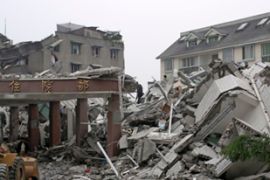No early warning signs
Earthquake prediction is said to be the ‘Holy Grail of seismology’.

In a study published in Nature, the British science weekly, in 2005, scientists sowed a 40km strip of the notorious San Andreas fault – in the city of Parkfield – with scores of seismic sensors to monitor earth rumbles and movement in real time.
But an earthquake measuring 6.0 on the Richter scale struck that region on 28 September 2004 without any warning.
There was not the slightest hint of a build-up of strain or impending landslip.
Parkfield had long been seen as a good test for earthquake physics as it had experienced seven big quakes since 1857, and these events were evenly spaced apart.
As a result, the US Geological Survey (USGS) was confident enough in 1985 to predict that a 6.0 quake would occur in Parkfield before 1993.
Right place, wrong time
 |
|
The South Asian quake in 2005 |
The USGS turned out to be right when it came to predicting the size of the event and the location, and the data sent back by the sensors was invaluable – but its timing was 11 years off.
In addition, the absence of any precursor signal meant the local population could not be warned in time.
“Earthquake prediction is the Holy Grail of seismology,” the Nature report said, adding: “The 2004 Parkfield earthquake, with its obvious lack of precursors, demonstrates that reliable short-term earthquake prediction is still not achievable.”
Given the huge task of achieving predictability, that study recommended that resources be devoted to improving computer models to help calculate how big a future quake will be and what kind of ground motion it is likely to cause.
This would have immediate benefit for people living in the vulnerable area and for rescue services.
Rare accuracy
One of the most spectacular cases of earthquake prediction was made earlier in 2005 by John McCloskey, a seismology professor at Britain’s University of Ulster.
 |
|
An 8.5-magnitude quake after the |
In an analysis of the enormous December 26, 2004 quake off Sumatra that caused the Indian Ocean tsunami, McCloskey said the stress had placed additional strain on a weak part of the same fault farther south.
On 17 March, 2005, McCloskey’s team warned that a quake of 8.5 magnitude in this newly stressed region was imminent. Eleven days later, an event measuring 8.7 occurred.
Such accuracy is extremely rare in seismology. McCloskey, like other experts, said he did not want to make predictions about timing because errors bred scepticism and complacency among the public.